Abstract
Increasing renewable energy share in total energy production is a direction that leads toward the European Union’s aims of carbon neutrality by 2050, as well as increasing energy self-sufficiency and independence. Some of the main challenges to increasing renewable energy share while providing an efficient and secure energy supply are related to the optimization and profitability of de-centralized energy production systems. Integration of energy storage systems in addition to decentralized renewable energy production, for example, by solar panels, leads to more effective electricity supply and smart energy solutions. The modeling of such a complex dynamic system can be performed using the system dynamics method. The main aim of this research is to build and validate the basic structure of the system dynamics model for PV and battery diffusion in the household sector. A system dynamics model predicting the implementation of battery storage in private households was created for the case study of Latvia. Modeling results reveal that under the right conditions for electricity price and investment costs and with the right policy interventions, battery storage technologies combined with PV panels have a high potential for utilization in the household sector. Model results show that in a baseline scenario with no additional policies, up to 21,422 households or 10.8% of Latvian households could have combined PV and battery systems installed in 2050. Moderate subsidy policy can help to increase this number up to 25,118.
1. Introduction
Renewables are our future. For decades now, the European Union (EU) has maintained its course toward increasing its renewable energy aims, with the current target set as at least 32% of renewable energy share in 2030 [1]. The EU climate or carbon neutrality targets set by the European Climate Law [2,3] prescribe greenhouse gas (GHG) emission reduction by at least 55% in 2030 and net-zero GHG emissions by 2050. A complementary effect to achieving the 55% GHG emission reduction by 2030 could be a renewable energy share increase to 38–40% of gross final consumption [4].
But, to get to that future, the challenges of today have to be solved. On one hand, recent technology advancements have promoted significant deployment of renewable energy technologies; for example, with an increase in photovoltaic (PV) module production, the prices have reduced significantly [5], and, consequentially, PV cost reduction is said to be one of the most important reasons for an increase in global installed capacity [6]. On the other hand, the practical concerns are frequently related to the fluctuating nature of solar resources and PV power intermittency [7,8] and subsequent overvoltage incidents [9]. Hence, the transition toward sustainable power generation from renewable sources is not viable without sufficient energy storage [10].
Energy storage systems (ESSs) provide the possibility to confront the problems that arise due to intermittent power generation by renewable energy systems [11]. ESSs also allow increasing our effective ability to harvest and consume renewable energy and simultaneously increase the renewable energy share in the demand profile. On the downside, ESS capacity configuration affects the system’s economic feasibility [7]. Montoya-Duque et al. [12] report that in isolated systems that require energy storage, CAPEX might be even two-fold. A significant challenge that is considered in ESS research with an aim to ensure system reliability is the sizing of the storage system [13].
There are various types of energy storage systems, i.e., battery energy storage, compressed air energy storage, hydrogen fuel cells, power-to-gas methane, superconducting magnetic energy storage and fly-wheel energy storage to name some [10,14]. Elmorshedy et al. [8] also report that hydraulic storage and supercapacitors are used in combination with PV and wind turbine systems. It is reported that electric batteries are deployed in 77.1% of cases and hydrogen tanks in 15.4% of cases of energy storage systems [8]. Hyvonen et al. [11] report lithium batteries to be most feasible for small-scale applications, while hydrogen and thermal energy storage is unfeasible for their considered scenario of individual detached houses. An integrated supercapacitor and battery system might improve system reliability and self-sufficiency and aid in overcoming the limitations of battery energy storage that arise due to the changing nature of household consumption load [8].
ESSs can be deployed at various scales. Landl and Kirchsteiger [9] use Matlab/Simulink to analyze a large-scale PV farm and battery energy storage system (BESS) in the European network context. Research on renewable energy source (RES) and ESS integrated use at the single-dwelling, multi-house and even village levels is currently progressing. At the community level, Mazzeo et al. [15] used the artificial neural network method for sizing and energy performance prediction of a hybrid renewable energy system that includes batteries (EV charging) for energy storage. Their model, which is implemented by using TRNSYS and Matlab simulation, is aimed at promoting Zero Energy District development [15]. Matera et al. [13] supplement the aforementioned model for a case of small office communities. Wang et al. [7] provide a literature overview on numerous models that have recently been developed for PV-integrated systems both in general and at the household level. They note that the research on village-level systems, their configuration and life cycle economic benefits is lacking [7]. Cirone et al. [16] also apply TRNSYS for the dynamic modeling of a system of four interconnected municipality buildings, which includes PV generation, battery energy storage and shared electricity use. Monroe et al. [17] elaborate even more by applying agent-based modeling to analyze the dynamics of electricity prices in a consumer–prosumer system at the neighborhood level and including storage solutions.
To stimulate households to implement onsite renewable energy generation, as well as to seize the additional opportunities provided by energy storage technologies, the performance of such systems in local and relevant conditions must be evaluated by modeling and prediction. Mazzeo et al. [18] report that HOMER (hybrid optimization model for electric renewables) and Matlab are the most widespread software programs for hybrid system analysis. Hyvonen et al. [11] modeled energy storage scenarios for a detached house in Finnish climate conditions by using a Matlab computational model with graphical capacity optimization. With a particular focus on system costs (including life cycle costs and levelized cost of storage), they found that the use of energy storage systems may only be feasible for households in detached houses in the case of (a) high electricity market prices or (b) the availability of economic support mechanisms [11]. But they also state that their previous experience has indicated linear optimization to be less than optimal for energy storage size elaboration [11]. Mascherbauer et al. [19] modeled a single-family house system including PV and battery storage, a hot water tank and thermal storage by building mass at the household and national levels in Austria with the aim to determine the potential of a smart energy management system. Wang et al. [7] use an optimization model (particle swarm optimization algorithm) to elaborate optimal energy storage capacity, power and typical energy storage output for different scenarios, including PV off-grid and on-grid systems for community context. The modeling inputs are based on cost–benefit analysis, and indicators such as the net present value and internal rate of return are used to determine the system’s economic feasibility. For the environmental dimension, Wang et al. [7] take into account the avoided greenhouse gas emissions (including, CO2, NO2, SO2) in g/kWh. Elmorshedy et al. [8] assessed the technoeconomic feasibility of a hybrid renewable energy system with energy storage. They used HOMER Pro platform software for the optimization of the studied design and integrated Matlab/Simulink modeling to analyze the dynamic changes in the system [8]. Miletić et al. [20] use a mixed integer linear programming (MILP) model for a household that includes PV, electric vehicle charging and a BESS. Bakić et al. [21] performed a dynamic analysis of a household PV and wind hybrid system by optimization simulation in the TRNSYS program. They noted that in order to achieve a constant electrical power supply from the system throughout the year, addition of energy storage is needed, e.g., batteries or a hydrogen-based system [21].
The abovementioned exemplifies that researchers are searching for ways to model the dynamic nature of an integrated RES and ESS smart system. Another suitable method would be system dynamics (SD) modeling. SD modeling is a computer-based modeling and simulation method [22] that allows one to uncover the causal relationships and feedback mechanisms underlying technological, economic and social systems [23]. The advantages of SD modeling include the model’s “open structure” and flexibility [22]. SD modeling has been applied to the case of solar-energy-based electric vehicle charging [24]. Kubli and Ulli-Beer [23] developed an SD model for the analysis of likely deployment patterns of decentralized energy generation, and Riveros et al. [25] applied SD to model diffusion of distributed generation and consumption (prosumer) communities. Jimenez et al. [26] analyzed how the diffusion of PV with or without battery storage affects the electricity supply system in Colombia. Castaneda [27] modeled a system that includes net metering but does not include energy storage solutions and analyzed how increasing the renewable share impacts the whole electricity industry. Later, Castaneda et al. [28] developed an SD model to assess the effects of feed-in tariff changes on PV and PV-BESS adoption by households in United Kingdom circumstances.
While there have been some previous SD studies regarding RES and ESS integration, the applications are still expanding, and the models have variation due to different national conditions. The contribution of this study is showcasing an alternative to the SD model design. The main aim of the research is to build and validate the basic structure of the system dynamics model for PV and battery diffusion in the household sector. Considering the complexity of this research direction, in the future, this base model structure can be extended further, and it can be adjusted for the initial energy system condition in foreign countries. Though we mainly focus on establishing a reliable initial model structure, policy testing is also applied, and provisional predictions of battery uptake in households are presented. After the sensitivity analysis, an initial forecast for the practice of electricity storage in Latvia in the coming decades is obtained from the validated model. The rest of the paper is structured as follows: SD model conceptualization, structure, input data and assumptions, as well as model validation, are described in Section 2. The results of simulations and sensitivity analysis are presented in Section 3. Finally, the overall discussion and conclusions are presented in Section 4.
2. Materials and Methods
In order to predict the practice of electricity storage in Latvia in the coming decades, the SD modeling method was used. Modeling was performed using Stella Architect 3.3 software.
SD is a method for studying the dynamic development of complex systems, with the help of which complex problems can be solved. SD theory is based on the study of the relationship between the behavior of the system and the underlying system structure. This means that by analyzing the structure of the system, a deeper understanding of the causes of the behavior of the system is formed, which allows us to better address the problematic behavior of the observed system [29].
SD was established in the mid-1950s by Professor Jay Wright Forrester of the Massachusetts Institute of Technology. SD was originally designed to help business leaders improve their understanding of production processes, but its application is now much wider, including policy analysis and development in both the public and private sectors [30].
For decades, system dynamics modeling has been employed in energy system research. The fundamental advantage of system dynamics over other modeling methodologies is its ability to capture the complexity of dynamic systems [29]. The most fundamental difference between system dynamics and other modeling methodologies is its endogenous approach, which means that model structure and elements defined within the system, rather than exogenous inputs, are responsible for dynamic behavior. System dynamics models can take into account four major factors that other modeling methods frequently overlook:
- Material and information delays;
- Non-linear relationships;
- Causation not correlation;
- Feedback in the system.
More information on how system dynamics is used in energy modeling, as well as the advantages over alternative modeling methodologies, may be found in the following works [31,32].
2.1. Model Contextualization
As defined by Sterman [33], there is no single best approach to successful modeling. However, his five-step guidelines, including (1) problem articulation, (2) formulation of dynamic hypothesis, (3) formulation of simulation model, (4) model testing and (5) policy design and evaluation [33], are widely used in SD model building [32,34] and also followed in current research.
The analyzed problem, as identified in the introduction, is the need to increase the share of renewable electricity, especially from carbon-neutral sources such as PV. Because PV technologies are fitting for decentralized applications, detached individual households are a significant beneficiary. Though a recent increase in PV installations is seen due to price competitiveness and subsidy policy, the installation of combined PV and BESS systems is still not widespread. The selected modeling timeframe is until 2050, corresponding to EU climate neutrality vision.
The dynamic hypothesis of the study is presented in Figure 1 in the form of a causal loop diagram.
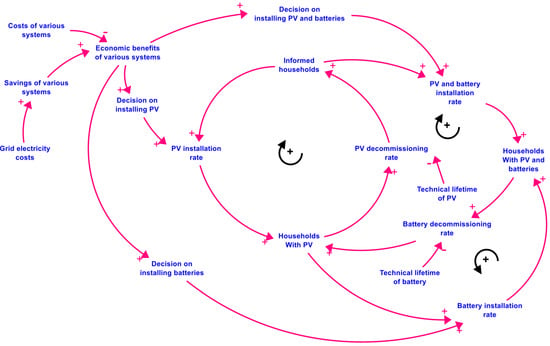
Figure 1.
Causal loop diagram of PV and battery storage diffusion.
The causal loop diagram displays the diffusion process of PV panels and battery storage in the household sector. The core element here is households that are informed about the possibility to install PV or batteries but have not yet decided to do so. This is the place from which the diffusion of specific technologies starts. Uninformed households cannot make the decision; only informed households can. The causal loop diagram shows several development pathways. Households can decide to install only PV panels, or they can decide to install a combined PV and battery storage system. The decision on which pathway to choose is made by comparing the economic benefits of separate systems, including the benefits of choosing none of the systems. Not only informed households can make the decision on installing the battery storage but also the households who already have PV installed. As the technologies do not have unlimited service life, decommissioning is also included in the modeling of the diffusion process. Each technology has a different service life; therefore, the rate at which decommissioning happens will vary based on the technology installed and the lifetime of the technology. Afterward, the decommissioning households can make the decision on which technology to install (if any) again.
The model structure for the system dynamics model was built based on the basic principles presented in the causal loop diagram in Figure 1.
2.2. Model Structure
As a result of the dynamic hypothesis, the system dynamics model predicting the implementation of battery storage in private households was created for the case study of Latvia. All the input parameters, like solar radiation, electricity price, number of households and other parameters used, were specific to the case of Latvia.
The numerical values of the model parameters are based on assumptions derived from the analysis of statistical databases, analyzing electricity market data, as well as other sources. The central part of the model structure is depicted in Figure 2. This part of the structure represents the main dynamics of PV panel and battery system installation. An important parameter in the development of this model is the total number of private households (single-family buildings) in Latvia. In this research, the installation of solar PV and battery storage systems is considered and forecasted only for single-family buildings with small-scale PV and battery systems. Based on the official Latvian statistics database, there are around 200,000 detached (single-family) households in Latvia. Part of these households have information about the possibility to implement micro-generation and storage applications in their households. Some households have already implemented these applications; however, there are still a large number of households that lack the information about micro-generation and storage or lack the information about advantages, which means that before the actual implementation of micro-generation or storage can happen, it is necessary to inform these households. Special information campaigns can be organized for this purpose; however, there is also word of mouth happening regardless of any information campaign. The inventory “Uninformed households” describes the part of private households in Latvia that still need to be specifically informed about alternatives for self-generating and storing electricity. When a household receives enough information about micro-generation and storage, it moves from the “Uninformed household” stock to the “Informed household” stock and is now ready to make decisions on micro-generation and storage implementation. These stocks are affected by the information rate, which depends on the informing fraction and in the model is assumed to be 0.1. In this research, the informing fraction is a single parameter including both information campaigns and word-of-mouth informing. At this stage, it is not modeled in more detail; however, the plan is to expand this section in future research. Equation (1) describes the flow.
where IR—information rate of uninformed households, units/year; HHUn—number of uninformed households, units; IFr—information fraction which describes the speed at which uninformed households get informed about PV and battery technologies.
IR = HHUn · IFr,
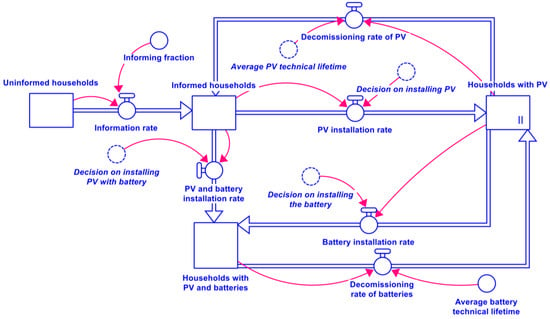
Figure 2.
PV and battery storage diffusion sub-model.
Accordingly, households that obtain information and begin to evaluate the installation of solar panels or batteries at some point come to a decision to install one of the options (PV, batteries or both) or to keep the current grid connection without additional technologies. Outgoing flows describe the total number of informed households and the decision made accordingly. The flow “PV installation rate” is described in the model by Equation (2). The outgoing flow “PV and battery installation rate” is also determined according to the same principle.
where InRi—installation rate of the specific solution, units/year; HHInf—number of informed households, units; Di—investment decision in a specific solution.
InRi = HHInf · Di,
The model also includes a flow “Battery installation rate”, which describes the number of households that decide to install a battery when PV panels are already installed previously or re-install a battery because the battery life is shorter than the life of the PV panel system duration.
The stock “Households with PV” describes the number of households that have installed only PV panels. On the other hand, the stock “Households with PV and batteries” describes the number of households that have not only installed PV but also added a battery. This number is not currently counted and analyzed in publicly available data in Latvia, but it was assumed that this number is minimal, setting five households as the initial value. Both of these stocks are also affected by the outflow, which describes the technology’s depreciation time, which is affected by the average lifetime of the technology. This means that after the end of the technical lifetime of the technology, the household returns to the previous stock. As the technical lifetime for batteries is shorter than for PV, households with PV and batteries move to the stock “Households with PV” after the technical lifetime of batteries has ended as they still have working PV panels left. Afterward, they can again make a decision on installing the batteries. “Households with PV” after the end of the technical lifetime for PV move back to the stock “Informed households” and can again make a decision on installing the PV or PV and batteries. The flow “Decommissioning rate of the PV” is determined according to Equation (3). The flow “Decommissioning rate of the batteries” is also determined according to the identical principle.
where DCi—decommissioning rate of the specific technology (PV or battery), units/year; HHi—number of households with specific technology solution, units; LTi—technical lifetime of the specific technology (PV or battery), years.
DCi = HHi/LTi,
The decision on installing the PV or battery system in the model is made based on the rentability of each system. Figure 3 represents the model structure responsible for decision making. For the system to be attractive, the payback time must be lower than the lifetime of the particular technology. Otherwise, the interest in installing the technology will be negligible, and the choice in favor of installing the specific technology will be made only by those for whom the financial aspect is not decisive in making the choice. It is usually a very tiny fraction. The interest of the rest of society increases if the payback time is shorter than the lifetime of the equipment. The faster the payback time, the greater the interest in choosing the particular technology. The decision regarding the choice of technology is calculated by using a logistic function in which the rentability of all the solutions, including installation of no technology, is compared. The highest share of decision makers opt for the solution with the fastest payback time, and the lowest share of decision makers choose the option with the longest payback time.
where Ri—payback time of the specific technology (years); α—elasticity coefficient that describes the decision-making nature of decision makers.
Di = exp(−α · Ri)/(exp(−α · R1) + exp(−α · R2) + exp(−α · R3)),

Figure 3.
Decision-making sub-model.
Decisions to install PV and battery systems are largely influenced by the amount of investment required and the payback time of technology installation. Investment costs depend on the installed capacity of the technology. Also, the payback time is affected by the granted subsidies and the intensity of support. On the other hand, the payback time is affected by the necessary investments for installing the technology, as well as the savings in electricity costs. The sub-model of these influencing parameters can be seen in Figure 4.
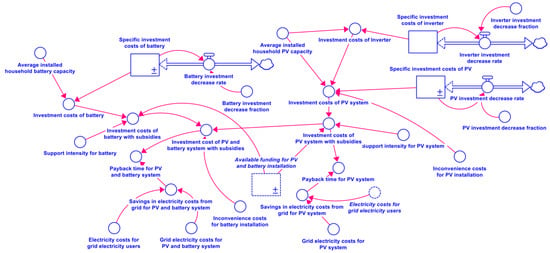
Figure 4.
Payback time calculation sub-model.
The payback time, if solar panels are installed for a household, is determined by the investment costs of the PV panels and the savings in electricity costs, which are respectively determined by the comparison of the annual electricity costs with grid connection versus the electricity costs with installed solar panels. Electricity costs for grid electricity users, grid electricity costs for the PV system and grid electricity costs for the PV and battery system were calculated by using a model previously developed by the authors [35]. In this research, electricity price was assumed to be constant for the whole simulation period; therefore, the costs of grid electricity for all three systems were also assumed to be constant for the whole simulation. The explanation of why the constant electricity price was chosen for this research is given in Section 2.2. Similarly, the payback time of the system with accumulation is affected by the corresponding savings in electricity costs and investment costs and is determined according to the formula of the same principle. The PV payback time is determined according to Equation (5).
where PTi—payback time for specific system (PV or PV and battery), years; ISi—investment costs for specific system (includes subsidies if granted), EUR; Si—savings made by using specific technology, EUR/year.
PTi = ISi/Si,
On the other hand, investment costs with subsidies depend on the investment costs of installing the technology, the intensity of the support and the amount of support available for increasing energy efficiency. This parameter in the PV system situation is calculated according to Equation (6). If the available support for increasing energy efficiency is available, then the investment costs depend on the intensity of the support; otherwise, the investment costs of the technology are taken into account. The investment costs of the battery system are also determined according to the same principle; only in this case, the costs of the PV system are additionally included because when installing the battery for the storage of renewable energy, it also resonates with the PV panel system.
where AF—available funding for PV and battery installation, EUR; Ii—total investment costs for specific system without subsidies, EUR; SIi—support intensity for specific technology (either PV or battery).
ISi = IF(AF > 0; Ii · (1 − Si); Ii),
The investment costs of PV depend on the installed capacity of the PV system, as well as the investment costs of the inverter, as it adds up to additional costs, as it also needs to be replaced when comparing lifetimes. Also, the parameter is affected by the specific investment cost, which is affected by the rate of cost decrease (which depends on the fraction of decrease and is assumed in the model to be a decrease of 0.02 units per year) as the costs of these technologies are expected to decrease over time.
where IPV—PV investment cost, EUR; CPV—installed PV capacity for household, kW; SpIPV—specific investment costs of PV, EUR/kW; IInv—investment costs of inverter, EUR.
IPV = CPV · SpIPV + IInv,
Also, the payback time parameter for determining savings, comparing the benefits of a PV-only system and a PV–battery system, is created according to the same structure and calculation equations.
The abovementioned stock “Available funding for PV and battery installation” comes from the sub-model with related flows and parameters shown in Figure 5.

Figure 5.
Support policy scheme sub-model.
The amount of support available in the stock is also affected by the allocation of the incoming flow of funding, which describes the additional planned funding. According to the data of the Ministry of Economy, support is planned in the amount of EUR 20 million; however, separate financing is available also from the Ministry of Climate and Energy and from the Ministry of Environmental Protection and Regional Development [36]. On the other hand, the amount in the stock is reduced by the outgoing flow “Funds utilization rate”, which describes the support granted to the implemented energy efficiency projects. Considering that the system dynamics model describes the predictive situation, and the model does not include all possible exceptional cases, as well as that the parameters are based on assumptions, the outgoing flow and its influencing parameters are determined according to the following equations. The outgoing flow is determined by formula (8) where, if the support requested at a given time is more than the available support, then it is included in the model, and the support is stopped.
where FU—funding utilization rate, EUR/year; FR—funding requested by households for PV and battery installation, EUR/year; DT—delta time of simulation, year.
FU = IF(FR > AF; AF/DT; FR),
On the other hand, the parameter “Total funds requested” depends on the requested support for the installation of the PV system, which is affected by the intensity of the support, the amount of installation and investment costs and the requested support for the installation of the storage system, which depends on the investment costs of the battery, system installation and the intensity of the support as well as the total available support. The parameter of the requested total funds is determined according to Equation (9).
where FRPV—funds requested for PV installation, EUR/year; FRB—funds requested for battery installation, EUR/year.
FR = IF(AF > 0; (FRPV + FRB)/DT; 0),
2.3. Input Data and Assumptions
In this section, the most relevant input data and assumptions used in the system dynamics model are described.
Relevant data about technologies are taken from technology catalogs. Information about average capacities for technologies is taken from statistics and scientific literature. Information about households is taken from statistic databases. The most relevant information used in the system dynamics model is shown in Table 1. These data represent the current situation of the system and are used as initial values in the model for scenario modeling displayed in Section 2.5, Table 3.

Table 1.
Model input parameters.
Historic electricity spot price data were taken from the NordPool database [42] for the years 2013 to 2022 to evaluate the change in electricity spot price and decide on the best value to use for battery diffusion forecast simulation. Average yearly values were compared. Historic data show (see Table 2) that there are fluctuations in electricity price from 2013 to 2020; however, the price stays between 34 and 50 euros per Megawatt-hour. Fluctuations are mostly due to changes in hydro resource availability and changes in natural gas price, as those are the main resources in electricity generation in Latvia. It is also dependent on the price of imported electricity. Years 2021 and 2022 came with several shocks to the system and it is clearly reflected in the huge increase in electricity price. Lower water levels in hydro reservoirs and lower wind energy production in the Nordic-Baltic region resulted in switching to more expensive electricity generation means. The increase in demand for natural gas and coal increased the price of resources, which is reflected in the electricity price. The Ukraine–Russia conflict also played a huge role in the electricity price increase because of sanctions put on Russia. As Latvia historically imported most of the natural gas from Russia, the natural gas price increase after the Ukraine–Russia conflict had a devastating effect on the energy sector, and the yearly average electricity price reached the unprecedented level of 227 euros per Megawatt-hour. As the Nordic-Baltic region has worked together in the last year to reduce the dependence on Russian natural gas, the prices of natural gas and electricity have gone down significantly; however, the overall electricity price is still higher than it was from 2013 to 2020. It is hard to predict what will be the electricity price in the future and how much time will be necessary for the energy system to adapt to the new reality; however, the authors believe that due to many wind and solar energy projects already at the building stage and many more in the planning phase, combined with the diversification of natural gas importers in the region, electricity prices will eventually go down. For the purpose of this research, it is assumed that the energy system will adapt to the shocks of 2021 and 2022, and the baseline price of electricity in the long term will be at the 2013 to 2020 level rather than at the 2021 or 2022 level.

Table 2.
NordPool yearly average electricity price for Latvia.
There is no information on how many households so far have installed battery storage; therefore, it is assumed that this number is negligible. The assumed number is 5 households.
It is also assumed that average electricity price will be constant for the whole simulation. The model allows us to make this parameter changeable, and in future research, this option might be exercised; however, the goal of the current research was to test the model structure, rather than to predict the electricity price changes, and therefore, for this research, electricity price was set as constant for whole simulation.
For subsidies, it was assumed that for all subsidy scenarios, EUR 20 million (based on national plans [36]) would be allocated at the beginning of the simulation, and new finances at the same EUR 20 million level would be allocated every 5 years.
2.4. Model Validation
To build confidence in a model, it is necessary to carry out several model validation tests. No model exactly matches the real object or system being modeled, so absolutely reliable models do not exist. Models are considered reliable and valid if they can be used with confidence. Forrester and Senghi believe that confidence is the most appropriate criterion for testing a model’s behavior because there is no absolute proof of a model’s ability to describe reality. In order to build confidence in the model’s validity as a result of model validation, the purpose of the model must first be clearly defined [43].
The purpose of the verification or approval of the system dynamics model is to determine the validity of the model structure. The accuracy of the reproduction of the real behavior of the model is also assessed, but this is only meaningful if we already have sufficient confidence in the structure of the model. Thus, the overall logical validation order is to first check the validity of the structure and then start testing the accuracy of behavior only after the model structure is perceived as adequate [44]. This sequence was also used in this research. There are several different structure and behavior tests, like model structure verification test, parameter verification test, dimensional consistency test, boundary adequacy test, extreme condition test, behavior reproduction test, behavior anomaly test and others.
Structure and parameter verification was performed by consulting energy experts and analyzing scientific literature to make sure that the structure of the created model complies with generally accepted principles and that all the parameters have matching elements in the real system. Since SD can be traced back to the engineering theory, SD models must ensure dimensional consistency. The dimensional consistency test provided an analysis of the dimensions of the parameters used in the model equations. This test allowed us to make sure that no inadvertent error had crept into any of the equations. An extreme condition test was carried out in order to make sure that the model would perform in an adequate manner even if the values fell out of the common range. It is important that the model works properly for different kinds of shocks.
Also, behavior validation tests were carried out to assess whether the model can represent the behavior of the real-life system. To assess the adequacy, model results were compared to the historic data of PV integration in households in Latvia. For this test, the historic input data for technology costs, electricity prices, relevant historic policies and other parameters were put into the model. The model was simulated from year 2013 to year 2022. As can be seen from Figure 6, the model describes the historic development of PV integration very well. Although simulated results do not exactly match the historic development, the overall trend is very similar, and this builds confidence in the model.
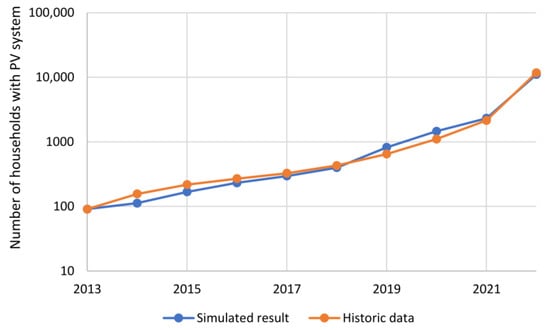
Figure 6.
Model validation with historical data for PV installation.
Historical development trends of battery implementation cannot be compared because, so far, the installation of batteries in households in Latvia has hardly taken place, and there is nothing to compare against. What validation showed in the case of the battery storage installation is the same as in the real-life system. Based on historic battery prices, technology parameters and electricity prices, model results showed that practically no battery systems were installed for the period from 2013 to 2022 because for the most part, the payback time was a lot higher than the lifetime of the battery. This also explains why there were almost no battery systems installed in Latvia during this period.
2.5. Defining Scenarios
This section describes the scenarios that were selected and modeled within this research. It describes what policy measures were chosen to be tested and what sensitivity parameters were chosen.
The main purpose of the research was to build and validate the system dynamics model which allows one to predict the future implementation of the PV and battery systems. To test out the validated model, it was supplemented with one policy measure—subsidies. As the main aim of the research was to build and validate the basic structure of the system dynamics model, rather than to analyze and assess the optimal way to promote battery storage diffusion in the household sector, only one policy measure was tested. In future research, the model can be supplemented with additional policies to test their effect on battery system integration in households. In this research, four separate scenarios were developed. The baseline scenario describes the system in which no additional policies are implemented apart from what is already existing in the current energy system. This is mainly related to the net metering for households that have installed PV systems. It allows for transferring excess solar energy to the grid when production is higher than consumption and taking it back when consumption is higher than the solar production of installed PV. This essentially means that the distribution grid is working as storage. The advantage comes from lower electricity prices when taking back the solar energy surplus. When accumulated solar energy surplus is taken back from the grid, only the distribution system operator tariff must be paid instead of the full electricity tariff. This is taken into account when calculating the costs of each system (grid only, PV, battery, PV and battery).
There are 3 separate subsidy scenarios (see Table 3). Each of them includes the already existing policies mentioned above and in addition provides subsidies for specific technology implementation. The main difference between scenarios is the technology that receives the subsidies and the amount of financial aid available. For scenarios in which only 1 technology receives the subsidies, the funding amount is EUR 20 million every 5 years; however, when both technologies receive subsidies, EUR 20 million is allocated separately for each technology implementation.

Table 3.
Scenario description.
2.6. Sensitivity Analysis
To test the sensitivity of the model to changes in various parameters, sensitivity analysis was carried out. Electricity tariff, technical lifetime of the battery, initial investment of the battery and battery investment decrease fraction were chosen as the four parameters with the most influence on the model results. Table 4 shows the intervals tested for sensitivity analysis. The results of the sensitivity analysis are displayed in the Results section. Sensitivity analysis was performed for each parameter separately. For parameters shown in Table 4, the specific interval was tested, while for other parameters, the values presented in Table 1 were used.

Table 4.
Parameters for sensitivity analysis.
3. Results
This section provides the key initial results that describe the diffusion of PV systems and electricity storage systems in households in Latvia up to the year 2050 based on different parameters. The sensitivity of the most relevant parameters is assessed.
3.1. Model Results
This is in a way an intuitive conclusion; however, electricity price proved to have a large role in the transition from grid electricity to PV and battery utilization. Figure 7 shows the comparison of PV and PV with battery system diffusion levels at different electricity tariffs. It can be seen in Figure 7a that if the electricity price for the whole simulation period was 35 euros per Megawatt-hour, which is about the lowest price electricity has reached in the last 10 years (see Table 2), interest in both PV and PV with battery installation would be very low. Most of the households would stay connected to the grid without additional production or storage capacities. Interest in batteries would start only after the year 2040 when investment costs would have decreased enough for payback time to be lower than the technical lifetime of batteries. It is logical that with low electricity prices, the payback time for PV and batteries is too long to make it a desirable option. Model results show that at this electricity price level in the year 2050, only 25.4% of all households would have installed PV-only systems, and 3.5% would have installed PV systems complemented with battery storage. The rest would still be fully dependent on grid electricity.
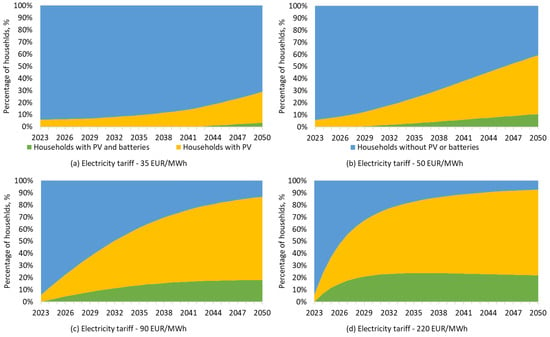
Figure 7.
PV and battery system diffusion based on electricity tariff.
Figure 7b shows that if the electricity price for the whole simulation period was 50 euros per Megawatt-hour, which was the highest electricity price from the year 2013 to 2020 (see Table 2), interest in PV and batteries would significantly increase. This means that payback time is significantly lower than it was at previous electricity prices, and micro-generation and storage technologies become more lucrative even without additional support from the government. PV technology implementation gains traction right out of the gate, while PV and battery installation has started to rise already, before 2030. Model results show that at this electricity price level in the year 2050, 48.6% of all households would have installed PV-only systems, and 10.8% would have installed PV systems complemented with battery storage.
Figure 7c shows that if the electricity price for the whole simulation period was 90 euros per Megawatt-hour, which is similar to the electricity price in the year 2021 (see Table 2), interest in PV and batteries would significantly increase. In this case, electricity price is so high that the current technology costs for PV and batteries are becoming very lucrative already at the beginning of the simulation, and payback time is very short. Even without government support, households make the decision to switch to PV or PV with batteries, and the future technology cost decrease promotes it even more; however, close to the year 2050, the installation rate slows down because the system is close to full saturation. Model results show that at this electricity price level in the year 2050, 68.6% of all households would have installed PV-only systems, and 18.0% would have installed PV systems complemented with battery storage.
Figure 7d shows that if the electricity price for the whole simulation period was 220 euros per Megawatt-hour, which was around the electricity price in the year 2022 (see Table 2), PV and battery installation rates would explode. Grid electricity is so expensive that even battery technologies that at this point are still expensive would seem to be more lucrative than using only grid electricity. PV-only systems still take a larger fraction than PV with batteries because total investment and payback time in PV will always be lower than for PV systems supplemented with batteries. Model results show that at this electricity price level in the year 2050, 70.8% of all households would have installed PV-only systems, and 22.0% would have installed PV systems complemented with battery storage. End results are similar to the ones with the electricity price at 90 euros per Megawatt-hour; however, the initial investment rate is significantly higher.
It is crucial to mention that results show the situation when net-metering systems are working for the whole simulation in all electricity price scenarios and all households can use this system; however, in reality, the distribution system operator most likely would not be able to accumulate all the solar surplus electricity showed in (c) and (d) scenarios in the grid, and net metering would be eliminated in order to keep the grid stability. This would in turn affect the PV and battery system integration rate because without net metering, the payback period increases, and grid connections look more attractive. In this research, however, the effect of the PV integration rate on the electricity grid and net-metering system is not analyzed. The model must be extended in order to analyze this effect. This is a goal for further research.
Figure 8 shows the PV and PV with batteries integration rate for the baseline scenario in which the electricity price was set at 50 euros per Megawatt-hour, which was assumed to be the most realistic future price level for the current study. In further studies, the price formation should be extended, and price variation should be considered.
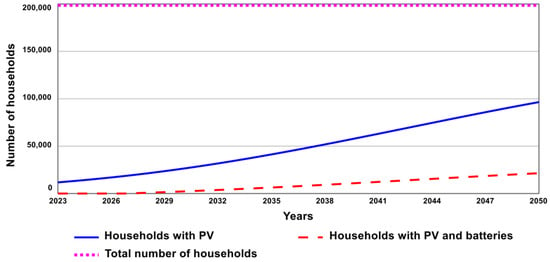
Figure 8.
PV and PV with battery integration in scenario 1.
The baseline scenario reveals the gradual increase in PV system installation from 11,764 in 2023 up to 96,497 households with PV in 2050. PV with battery installation starts in the year 2027 and goes up from 5 households in 2027 to 21,422 households with PV and battery combination in 2050. This shows that there is potential for battery integration in households; however, to reach the higher integration rate, support policy implementation is necessary.
Figure 9 shows how the subsidy policy implementation changes the PV with battery system integration in households. It can be seen that the baseline scenario with no policies shows the lowest number of households with PV and battery storage in 2050. When subsidies are given only for PV installation, but not for battery storage, the initial increase in the installation of systems with PV and batteries is higher than for the baseline scenario; however, the end result is only slightly higher. The initial increase is due to the fact that by subsidizing PV installation, the total cost of the system with PV and batteries is also reduced; therefore, it is more attractive than in the baseline scenario. However, in the long term, PV-only systems are still more attractive than a combined system.
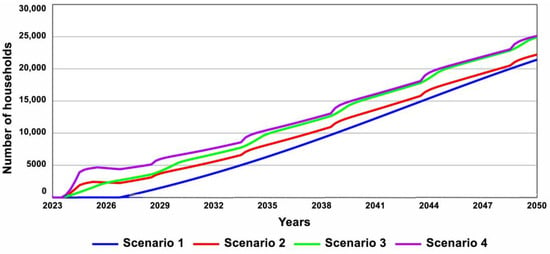
Figure 9.
Model scenario comparison.
When only batteries are subsidized, the initial increase in PV and battery system installation is similar to the one with PV subsidies and higher than in the baseline scenario; however, the end result is better than in the baseline and subsidies for the PV-only scenario. This can be explained by the fact that by subsidizing only batteries, the payback time for the combined system is closer to the PV-only system; therefore, interest in combined PV and battery system installation increases and increases not only for the initial period but throughout the simulation.
If both technologies are subsidized, it is predictable that the initial increase will be higher than in previous scenarios. This increase happens not at the expense of PV-only systems but because both PV-only and combined PV and battery systems become competitive with a grid electricity tariff, and an installation increase happens in both categories. The end result, however, is similar to the scenario with subsidies for batteries only, and as both technologies receive subsidies, investment and saving differences between solutions are still in favor of the PV system.
From the scenario results can be seen the fact that EUR 20 million subsidies every 5 years for technologies with 50% support intensity is not enough to significantly increase the adoption of combined PV and battery systems. The difference between the baseline scenario and subsidy for both technologies’ scenarios is 3696 households. In the baseline scenario, 21,422 households have combined PV and battery systems installed, while in the scenario with subsidies for both technologies, 25,118 households have combined PV and battery systems installed.
3.2. Results of Sensitivity Analysis
Sensitivity analysis was carried out in order to assess how the changes in most relevant parameters might impact the implementation of combined PV and battery systems. Sensitivity analysis was performed for the system without subsidies. Figure 10 shows the sensitivity of the electricity tariff. A huge gap can be seen between PV and battery system installation at electricity prices of 30 and 150 euros per Megawatt-hour.
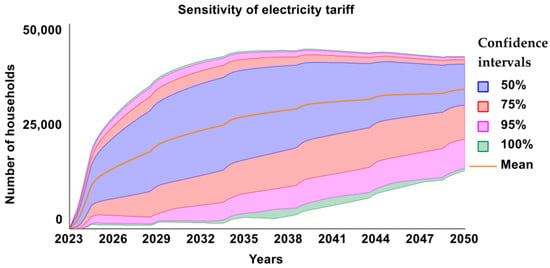
Figure 10.
Sensitivity analysis of electricity tariff on battery storage installation (tariff interval: 30–150 EUR per MWh).
Technical lifetime of the battery also has a high impact on the combined PV and battery system installation. Figure 11 shows that if the battery technical lifetime was 10 years or lower, almost no installation of battery storage would take place because the investment would be too high to pay off within the lifetime of the technology.
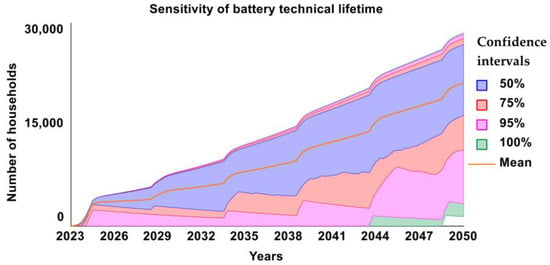
Figure 11.
Sensitivity analysis of battery technical lifetime on battery storage installation (technical lifetime interval: 10–30 years).
Initial investment also plays a huge role in battery storage implementation, and sensitivity analysis shows how the installed amount of PV and battery systems changes when increasing or decreasing initial investment by 25%. The number of households with PV and battery systems changes from 19,890 in the highest-investment scenario to 31,029 in the lowest-investment scenario (see Figure 12).
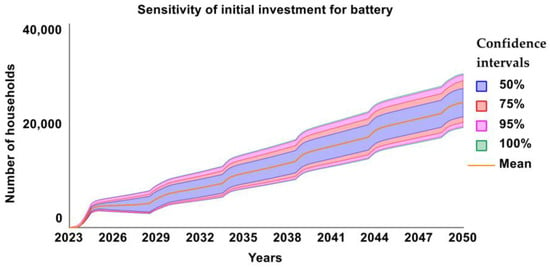
Figure 12.
Sensitivity analysis of initial investment on battery storage installation (initial investment interval: 600–1000 EUR per kWh).
Not only initial investment itself but also investment decrease over time plays a role in battery system integration. Sensitivity analysis of the investment decrease fraction (see Figure 13) shows significant changes in the end result when changing the yearly investment decrease fraction from 0.5 to 3%. The number of households with PV and battery systems changes from 19,127 in the lowest-investment-decrease-fraction scenario to 28,840 in the highest-investment-decrease-fraction scenario.
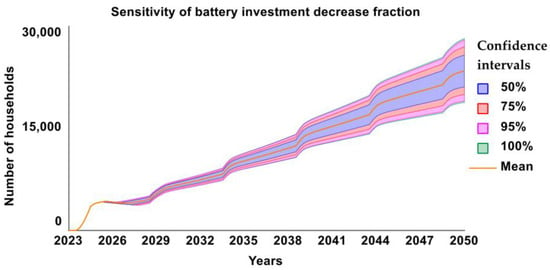
Figure 13.
Sensitivity analysis of battery investment decrease fraction on battery storage installation (battery investment decrease fraction interval: 0.5–3% per year).
From sensitivity analysis can be seen that all four parameters—electricity price, technical lifetime of the battery storage, initial investment of battery storage and investment decrease fraction of battery storage—have a huge impact on the battery storage installation, and therefore, it is crucial to carefully consider the values of these parameters when making a future prediction on battery storage development.
4. Discussion and Conclusions
Extensive testing and validation of the model were performed before the forecast simulation and sensitivity analysis. Model testing results built confidence in the model’s adequacy and reliability. Behavior validation results showed the same development trend of PV system integration in households as historic data.
Results showed the potential for the integration of battery storage in the household sector. Although the battery storage implementation rate is heavily dependent on electricity prices, the moderate scenario model results show that a total of 21,422 households could install battery storage until 2050 if the electricity price level on average stays around 50 euros per Megawatt-hour, and no support policies are implemented aside from the ones already in place. In addition, 21,422 households are more than 10% of all households in Latvia. This is also in line with the research conducted by Australian researchers in which a no-policy slow-growth scenario showed a similar increase of around 13% until 2050 [45]. Australians projected that with additional policies in the best-case scenario, up to 50% of households could have battery storage installed by 2050. For a model of the United Kingdom’s energy system, 30% PV penetration is projected based on only a high feed-in tariff measure (in a system without a net-metering measure) [28]. For our model, additional policy implementation and testing are planned for future research.
The initial testing of subsidy policies highlights subsidizing both technologies at the same time, instead of separately. Results showed that by implementing subsidy policy and funding both PV and battery installation, the number of households with combined PV and battery systems increased by 3696 households from 21,422 to 25,118 when compared to the baseline scenario.
Electricity prices have a huge impact on battery storage implementation. In the last few years, Latvia has experienced a significant increase in electricity price. This has resulted in a significant increase in the demand for PV system installation in the household sector. Though the battery installation rate in Latvia is still low, model results show that if electricity prices remain high and battery investment costs keep falling, combined PV and BESS installations will gain traction, and a rapid increase in battery storage implementation can be predicted.
In addition to electricity prices, other parameters like the technical lifetime of batteries, initial investment and investment decrease fraction are very sensitive to changes, and even small or moderate changes in these parameters can have a huge impact on future battery storage installation rates.
For the current model configuration, only scenarios with different subsidy levels were tested. Further development of the model’s structure and adjustment to varied initial conditions (e.g., according to a particular country’s energy system) would allow us to add additional policies and test what is the highest percentage of households with battery storage that can be reached.
In future research, the model shall also be complemented with an extended structure for information transfer from uninformed to informed households. Information about available technologies and their benefits is key to transforming the energy sector and increasing the PV and battery system installation rate. Only households with access to qualitative information can make rational decisions. The differences in various households’ abilities to afford PV and, especially, battery technology solutions is another area of research that can be elaborated; hence, SD methodology can be well used to combine economic and technical aspects. The model must also be complemented with additional effects between existing elements to increase the adequacy of the model even more. For example, the current model does not consider links between the installed amount of PV or battery capacity and electricity distribution tariff due to increased costs for infrastructure maintenance and expansion; however, the real-life system has this link. There is also a link between the installed amount of PV and battery systems and the installation rate in real-life systems, which is not included in the current version of the model.
Author Contributions
Conceptualization, E.A., A.G., E.K., A.K. and D.B.; methodology, E.A. and A.G.; validation, A.G. and D.B.; formal analysis, E.A. and E.K.; data curation, E.A. and E.K.; writing—original draft preparation, A.G. and A.K.; writing—review and editing, A.G., E.K., E.A., A.K. and D.B.; visualization, E.A. and A.G.; supervision, D.B.; funding acquisition, E.K. All authors have read and agreed to the published version of the manuscript.
Funding
This work has been supported by the European Social Fund within Project No. 8.2.2.0/20/I/008 «Strengthening of PhD students and academic personnel of Riga Technical University and BA School of Business and Finance in the strategic fields of specialization» of the Specific Objective 8.2.2 «To Strengthen Academic Staff of Higher Education Institutions in Strategic Specialization Areas» of the Operational Programme «Growth and Employment».
Data Availability Statement
No publicly available database is generated during this study.
Acknowledgments
The authors would like to thank the anomymous reviewers for their useful comments and insight.
Conflicts of Interest
The authors declare no conflict of interest. The funders had no role in the design of the study; in the collection, analyses or interpretation of data; in the writing of the manuscript; or in the decision to publish the results.
References
- European Parliament. Directive (EU) 2018/2001 of the European Parliament and of the Council of 11 December 2018 on the Promotion of the Use of Energy from Renewable Sources (Recast). Off. J. Eur. Union 2018, 82–209. [Google Scholar]
- European Commission. Proposal for a Regulation of the European Parliament and of the Council establishing the Framework for Achieving Climate Neutrality and Amending Regulation (EU) 2018/1999 (European Climate Law). 4 March 2020; pp. 1–46. Available online: https://eur-lex.europa.eu/legal-content/EN/TXT/?uri=CELEX%3A52020PC0080 (accessed on 15 September 2023).
- European Commission. Amended Proposal for a Regulation of the European Parliament and of the Council on Establishing the Framework for Achieving Climate Neutrality and Amending Regulation (EU) 2018/1999 (European Climate Law). 17 September 2020; pp. 1–6. Available online: https://eur-lex.europa.eu/legal-content/EN/TXT/?uri=CELEX%3A52020PC0563 (accessed on 15 September 2023).
- Scarlat, N.; Prussi, M.; Padella, M. Quantification of the carbon intensity of electricity produced and used in Europe. Appl. Energy 2022, 305, 117901. [Google Scholar] [CrossRef]
- Oreski, G.; Stein, J.S.; Eder, G.C.; Berger, K.; Bruckman, L.; French, R.; Vedde, J.; Weiß, A.K. Motivation, benefits, and challenges for new photovoltaic material & module developments. Prog. Energy 2022, 4, 032003. [Google Scholar] [CrossRef]
- Gielen, D.; Boshell, F.; Saygin, D.; Bazilian, M.D.; Wagner, N.; Gorini, R. The role of renewable energy in the global energy transformation. Energy Strategy Rev. 2019, 24, 38–50. [Google Scholar] [CrossRef]
- Wang, W.; Kang, K.; Sun, G.; Xiao, L. Configuration optimization of energy storage and economic improvement for household photovoltaic system considering multiple scenarios. J. Energy Storage 2022, 67, 107631. [Google Scholar] [CrossRef]
- Elmorshedy, M.F.; Elkadeem, M.; Kotb, K.M.; Taha, I.B.; Mazzeo, D. Optimal design and energy management of an isolated fully renewable energy system integrating batteries and supercapacitors. Energy Convers. Manag. 2021, 245, 114584. [Google Scholar] [CrossRef]
- Landl, S.; Kirchsteiger, H. Mitigating Overvoltage in Power Grids with Photovoltaic Systems by Energy Storage. Environ. Clim. Technol. 2022, 26, 470–483. [Google Scholar] [CrossRef]
- Sridhar, S.; Salkuti, S.R. Development and Future Scope of Renewable Energy and Energy Storage Systems. Smart Cities 2022, 5, 668–699. [Google Scholar] [CrossRef]
- Hyvönen, J.; Santasalo-Aarnio, A.; Syri, S.; Lehtonen, M. Feasibility study of energy storage options for photovoltaic electricity generation in detached houses in Nordic climates. J. Energy Storage 2022, 54, 105330. [Google Scholar] [CrossRef]
- Montoya-Duque, L.; Arango-Aramburo, S.; Arias-Gaviria, J. Simulating the effect of the Pay-as-you-go scheme for solar energy diffusion in Colombian off-grid regions. Energy 2022, 244, 123197. [Google Scholar] [CrossRef]
- Matera, N.; Mazzeo, D.; Baglivo, C.; Congedo, P.M. Energy Independence of a Small Office Community Powered by Photovoltaic-Wind Hybrid Systems in Widely Different Climates. Energies 2023, 16, 3974. [Google Scholar] [CrossRef]
- Ortega, A.; Milano, F. Generalized Model of VSC-Based Energy Storage Systems for Transient Stability Analysis. IEEE Trans. Power Syst. 2016, 31, 3369–3380. [Google Scholar] [CrossRef]
- Mazzeo, D.; Herdem, M.S.; Matera, N.; Bonini, M.; Wen, J.Z.; Nathwani, J.; Oliveti, G. Artificial intelligence application for the performance prediction of a clean energy community. Energy 2021, 232, 120999. [Google Scholar] [CrossRef]
- Cirone, D.; Bruno, R.; Bevilacqua, P.; Perrella, S.; Arcuri, N. Techno-Economic Analysis of an Energy Community Based on PV and Electric Storage Systems in a Small Mountain Locality of South Italy: A Case Study. Sustainability 2022, 14, 13877. [Google Scholar] [CrossRef]
- Monroe, J.G.; Hansen, P.; Sorell, M.; Berglund, E.Z. Agent-Based Model of a Blockchain Enabled Peer-to-Peer Energy Market: Application for a Neighborhood Trial in Perth, Australia. Smart Cities 2020, 3, 1072–1099. [Google Scholar] [CrossRef]
- Mazzeo, D.; Matera, N.; De Luca, P.; Baglivo, C.; Congedo, P.M.; Oliveti, G. A literature review and statistical analysis of photovoltaic-wind hybrid renewable system research by considering the most relevant 550 articles: An upgradable matrix literature database. J. Clean. Prod. 2021, 295, 126070. [Google Scholar] [CrossRef]
- Mascherbauer, P.; Kranzl, L.; Yu, S.; Haupt, T. Investigating the impact of smart energy management system on the residential electricity consumption in Austria. Energy 2022, 249, 123665. [Google Scholar] [CrossRef]
- Miletić, M.; Gržanić, M.; Pavić, I.; Pandžić, H.; Capuder, T. The effects of household automation and dynamic electricity pricing on consumers and suppliers. Sustain. Energy Grids Netw. 2022, 32, 100931. [Google Scholar] [CrossRef]
- Bakić, V.; Pezo, M.; Stevanović, Ž.; Živković, M.; Grubor, B. Dynamical simulation of PV/Wind hybrid energy conversion system. Energy 2012, 45, 324–328. [Google Scholar] [CrossRef]
- Barisa, A.; Kirsanovs, V.; Safronova, A. Future transport policy designs for biomethane promotion: A system Dynamics model. J. Environ. Manag. 2020, 269, 110842. [Google Scholar] [CrossRef]
- Kubli, M.; Ulli-Beer, S. Decentralisation dynamics in energy systems: A generic simulation of network effects. Energy Res. Soc. Sci. 2016, 13, 71–83. [Google Scholar] [CrossRef]
- Valdmanis, G.; Rieksta, M.; Luksta, I.; Bazbauers, G. Solar Energy Based Charging for Electric Vehicles at Fuel Stations. Environ. Clim. Technol. 2022, 26, 1169–1181. [Google Scholar] [CrossRef]
- Zapata Riveros, J.; Kubli, M.; Ulli-Beer, S. Prosumer communities as strategic allies for electric utilities: Exploring future decentralization trends in Switzerland. Energy Res. Soc. Sci. 2019, 57, 101219. [Google Scholar] [CrossRef]
- Jimenez, M.; Franco, C.J.; Dyner, I. Diffusion of renewable energy technologies: The need for policy in Colombia. Energy 2016, 111, 818–829. [Google Scholar] [CrossRef]
- Castaneda, M.; Franco, C.J.; Dyner, I. Evaluating the effect of technology transformation on the electricity utility industry. Renew. Sustain. Energy Rev. 2017, 80, 341–351. [Google Scholar] [CrossRef]
- Castaneda, M.; Zapata, S.; Cherni, J.; Aristizabal, A.J.; Dyner, I. The long-term effects of cautious feed-in tariff reductions on photovoltaic generation in the UK residential sector. Renew. Energy 2020, 155, 1432–1443. [Google Scholar] [CrossRef]
- Aslani, A.; Helo, P.; Naaranoja, M. Role of renewable energy policies in energy dependency in Finland: System dynamics approach. Appl. Energy 2014, 113, 758–765. [Google Scholar] [CrossRef]
- Currie, D.J.; Smith, C.; Jagals, P. The application of system dynamics modelling to environmental health decision-making and policy—A scoping review. BMC Public Health 2018, 18, 1–11. [Google Scholar] [CrossRef]
- Qudrat-Ullah, H. Modelling and Simulation in Service of Energy Policy. Energy Procedia 2015, 75, 2819–2825. [Google Scholar] [CrossRef]
- Bolwig, S.; Bazbauers, G.; Klitkou, A.; Lund, P.D.; Blumberga, A.; Gravelsins, A.; Blumberga, D. Review of modelling energy transitions pathways with application to energy system flexibility. Renew. Sustain. Energy Rev. 2018, 101, 440–452. [Google Scholar] [CrossRef]
- Sterman, J. Business Dynamics: Systems Thinking and Modeling for a Complex World; Irwin/McGraw-Hill: Irvine, CA, USA, 2000. [Google Scholar]
- Ziemele, J.; Gravelsins, A.; Blumberga, A.; Vigants, G.; Blumberga, D. System dynamics model analysis of pathway to 4th generation district heating in Latvia. Energy 2016, 110, 85–94. [Google Scholar] [CrossRef]
- Atvare, E.; Gravelsins, A.; Kudurs, E.; Rozakis, S.; Blumberga, D. When household becomes environmentally friendly—Dynamic simulation of hybrid energy system’s feasibility. Environments 2023, 10, 164. [Google Scholar] [CrossRef]
- Comparison of Support Programs for Citizens. Available online: https://ekii.lv/index.php?page=programmu-salidzinajums (accessed on 23 August 2023). (In Latvian).
- The Danish Energy Agency. Catalogues of Technology Data by Danish Energy Agency. Available online: https://ens.dk/en/our-services/projections-and-models/technology-data (accessed on 15 September 2023).
- Ramasamy, V.; Feldman, D.; Desai, J.; Margolis, R.U.S. Solar Photovoltaic System and Energy Storage Cost Benchmarks: Q1 2021. 2021. Available online: www.nrel.gov/publications (accessed on 15 September 2023).
- Distribution System Operator. Electrical Supply Review. 2023. Available online: https://sadalestikls.lv/lv/elektroapgades-apskats (accessed on 23 August 2023).
- Mulleriyawage, U.G.K.; Shen, W.X. Optimally sizing of battery energy storage capacity by operational optimization of residential PV-Battery systems: An Australian household case study. Renew. Energy 2020, 160, 852–864. [Google Scholar] [CrossRef]
- Central Statistics Bureau.Traditional Dwellings and the Persons Living in Them by Building Type and Time of Construction in Regions, Republican Cities, Counties and Neighborhoods 2011–2021. Available online: https://data.stat.gov.lv/pxweb/en/OSP_PUB/START__POP__MA__MAS/MAS070/ (accessed on 15 September 2023). (In Latvian)
- NordPool Market Data. Available online: https://www.nordpoolgroup.com/ (accessed on 23 August 2023).
- Forrester, J.W.; Senge, P.M. Tests for building confidence in system dynamics models. TIMS Stud. Manag. Sci. 1980, 14, 209–228. [Google Scholar]
- Barlas, Y.; Erdem, A. Output Behavior Validation in System Dynamics Simulation. In Proceedings of the European Simulation Symposium, Istanbul, Turkey, 9–12 October 1994; Volume 1, pp. 1–4. [Google Scholar]
- Green Energy Markets. Final 2021 Projections for Distributed Energy Resources—Solar Pv and Stationary Energy Battery Systems; Report for AEMO; Green Energy Markets Pty Ltd.: Hawthorn, Australia, 2021; pp. 1–93. [Google Scholar]
Disclaimer/Publisher’s Note: The statements, opinions and data contained in all publications are solely those of the individual author(s) and contributor(s) and not of MDPI and/or the editor(s). MDPI and/or the editor(s) disclaim responsibility for any injury to people or property resulting from any ideas, methods, instructions or products referred to in the content. |
© 2023 by the authors. Licensee MDPI, Basel, Switzerland. This article is an open access article distributed under the terms and conditions of the Creative Commons Attribution (CC BY) license (https://creativecommons.org/licenses/by/4.0/).